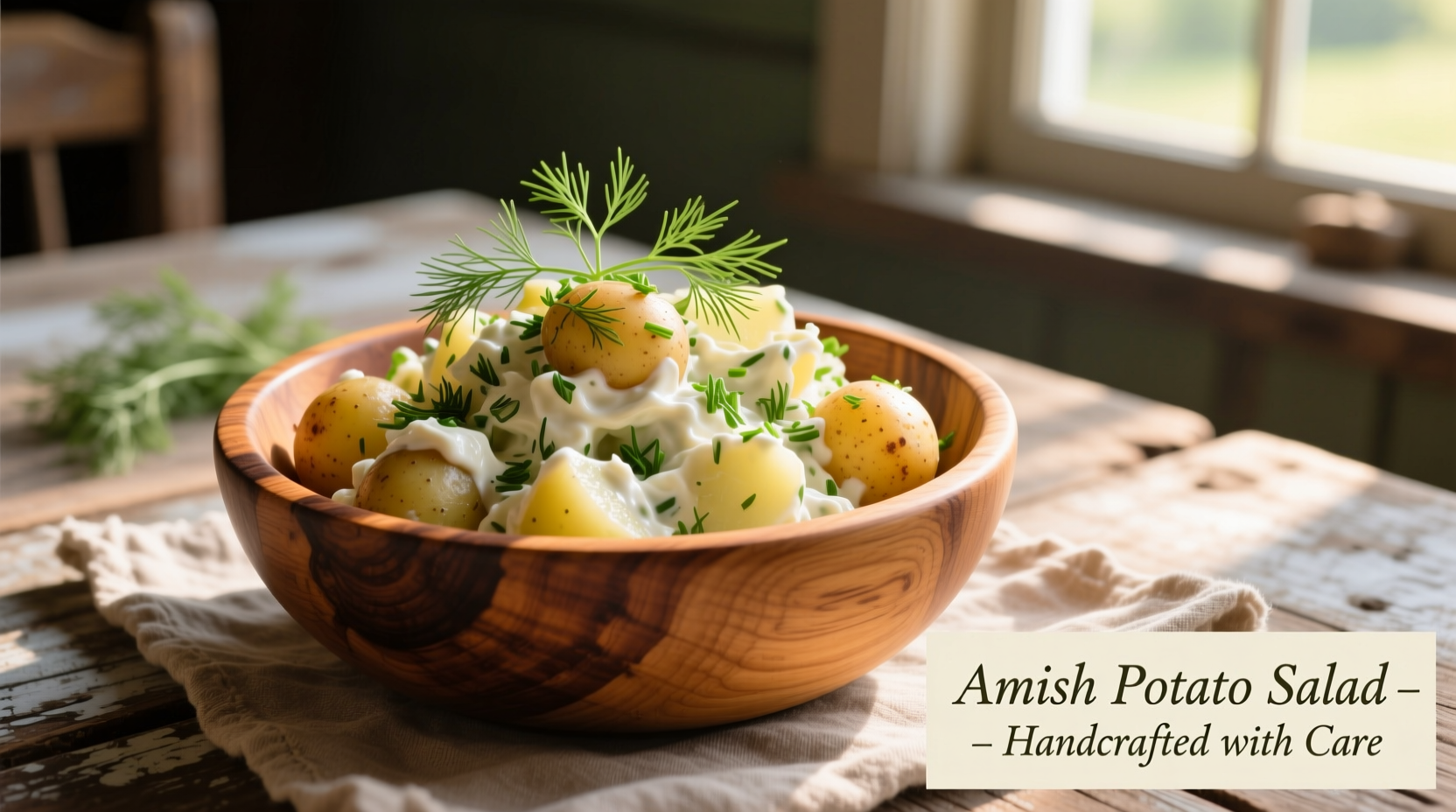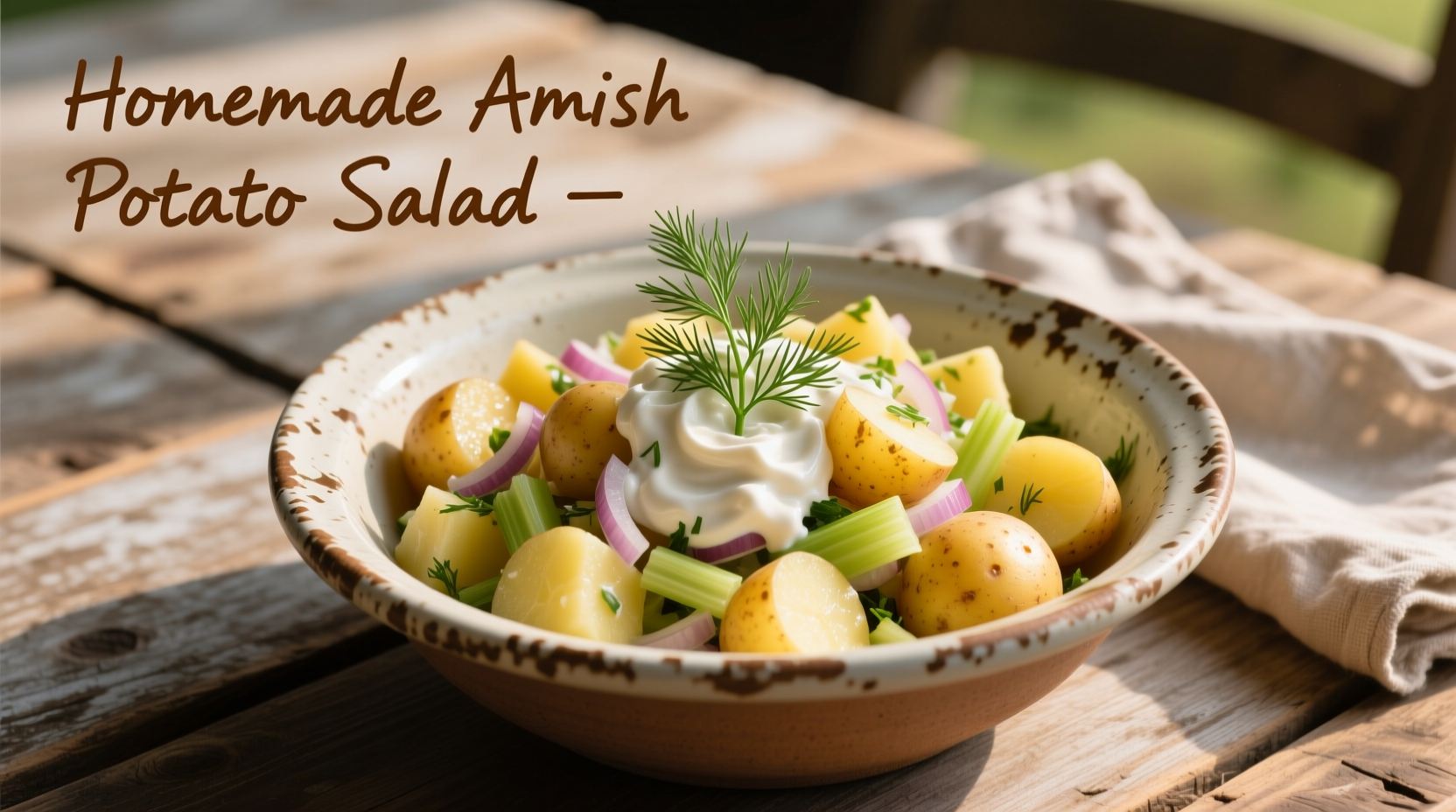Discover why this humble dish has become a staple at church picnics and family gatherings across Amish communities. Unlike conventional potato salads that rely on mayonnaise-heavy dressings, authentic Amish potato salad showcases a tangy vinegar dressing that keeps beautifully without refrigeration—perfect for outdoor gatherings where electricity isn't available.
The Roots of Amish Potato Salad Tradition
Amish potato salad emerged from the Pennsylvania Dutch farming communities in the 18th century, developed by settlers who brought German culinary traditions to North America. This dish evolved as a practical solution for church gatherings and harvest meals where food needed to remain safe without refrigeration. The vinegar-based dressing wasn't just a flavor choice—it was a food preservation technique passed down through generations.
| Traditional Amish Potato Salad | Standard American Potato Salad |
|---|---|
| Vinegar-based dressing | Mayonnaise-heavy dressing |
| No mustard | Typically contains mustard |
| Simple ingredient list (6-8 items) | Often includes multiple add-ins |
| Designed for room-temperature serving | Requires refrigeration |
This comparison highlights why food historians like Dr. William Woys Weaver, author of As American as Shoofly Pie, consider Amish potato salad a perfect example of "food adaptation"—where immigrant communities modified Old World recipes using available New World ingredients while maintaining core culinary principles.
Essential Ingredients for Authentic Flavor
The magic of traditional Amish potato salad lies in its restraint. You'll need just eight simple ingredients, all historically available to Amish households:
- Yukon Gold potatoes (waxy varieties hold shape best)
- Hard-boiled eggs
- Yellow onions (finely diced)
- Apple cider vinegar
- Granulated sugar
- Salt and pepper
- Vegetable oil or rendered bacon fat
- Optional: fresh dill or celery seed
According to research from the Penn State Extension, the vinegar-to-oil ratio (typically 1:2) creates an acidic environment that inhibits bacterial growth, making this salad safer for extended room-temperature service than mayonnaise-based versions. This food safety aspect was crucial in communities without access to refrigeration.

Step-by-Step Preparation Guide
Follow these steps to create an authentic Amish potato salad that honors traditional methods while ensuring food safety:
- Prepare potatoes: Boil 2 pounds Yukon Gold potatoes (unpeeled) until tender but firm. Cool slightly, then peel and slice into 1/4-inch pieces.
- Create dressing: Whisk together 1/2 cup apple cider vinegar, 1 cup vegetable oil, 3 tablespoons sugar, 1 teaspoon salt, and 1/2 teaspoon pepper.
- Combine while warm: Place warm potatoes in a large bowl, pour dressing over while potatoes are still warm (130-140°F), and gently fold to coat.
- Add remaining ingredients: Mix in 3 chopped hard-boiled eggs and 1/2 cup finely diced onions.
- Rest and serve: Cover and let sit at room temperature for 1-2 hours before serving to allow flavors to meld.
The USDA Food Safety and Inspection Service recommends that potato salads with vinegar-based dressings remain safe at room temperature for up to 2 hours, making Amish potato salad particularly suitable for outdoor events. This aligns with traditional Amish practices where food is prepared for community gatherings that might last several hours without refrigeration.
Avoiding Common Preparation Mistakes
Many home cooks unintentionally compromise authenticity when making Amish potato salad. Watch for these pitfalls:
- Using red potatoes: While acceptable in some variations, Yukon Golds provide the ideal texture and buttery flavor preferred in traditional recipes.
- Adding mustard: Authentic Amish potato salad contains no mustard—this is a key differentiator from German-style potato salads.
- Refrigerating too soon: The dressing needs time to absorb into warm potatoes; immediate refrigeration prevents proper flavor development.
- Over-mixing: Gently fold ingredients to maintain potato integrity—mashing creates an unappealing texture.
Serving Traditions and Modern Adaptations
Traditionally served at church frolics (community work gatherings) and Sunday dinners, Amish potato salad pairs perfectly with roasted meats, fresh bread, and seasonal vegetables. While purists maintain the original recipe, some contemporary adaptations include:
- Adding crispy bacon for smokiness (common in Lancaster County variations)
- Substituting honey for sugar in the dressing
- Including fresh herbs like dill or parsley
- Using sweet onions instead of yellow onions for milder flavor
Food anthropologist Dr. Karen Hess noted in her research that Amish food traditions demonstrate "culinary resilience"—maintaining core identity while selectively incorporating outside influences. This explains why some Amish communities have adopted minor variations while preserving the salad's essential character.
Storage and Food Safety Guidelines
While Amish potato salad was designed for room-temperature service, modern food safety standards recommend:
- Consume within 2 hours if kept at room temperature
- Refrigerate leftovers immediately in airtight containers
- Consume refrigerated salad within 3-4 days
- Do not freeze (potatoes become grainy upon thawing)
These guidelines balance tradition with contemporary food safety knowledge, ensuring you can enjoy this historic dish without compromising safety. The FDA Food Code specifically notes that vinegar-based dressings with pH below 4.6 create an environment less hospitable to bacterial growth, explaining the historical safety of this preparation method.











 浙公网安备
33010002000092号
浙公网安备
33010002000092号 浙B2-20120091-4
浙B2-20120091-4